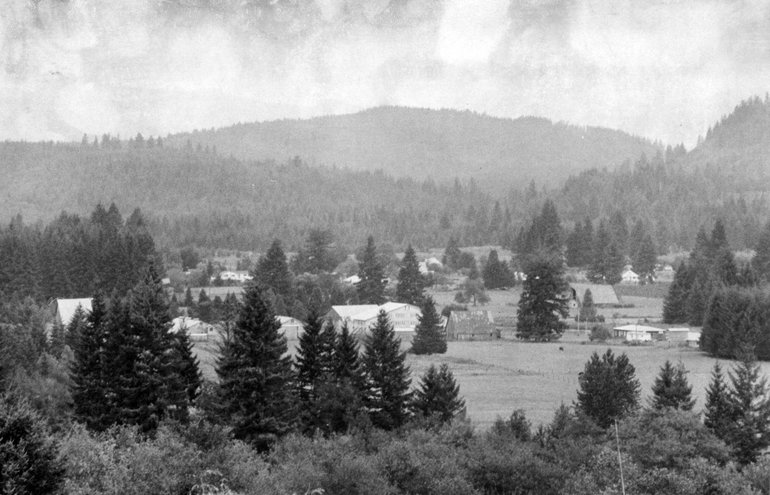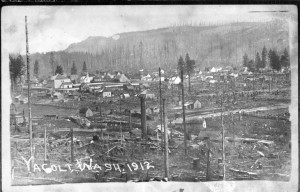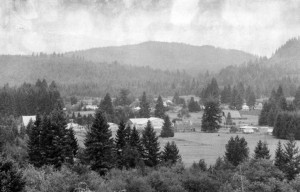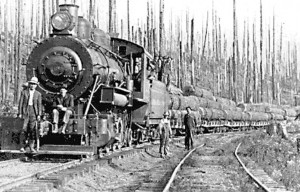
This story about haunted Yacolt ran in The Columbian on October 29, 2011.
The misty afternoon drizzle only drew a few wandering souls into Yacolt’s Whistle Stop restaurant, but the foggy rain was a fitting backdrop to the conversation between patrons.
It started when Shannon Thompson, who both owns and lives above the establishment, described a strange encounter.

This 1906 photo shows a home owned by Gus and Anna Minuth. Note the burned trees that surround it, destroyed by the Yacolt Burn of 1902. (Files/The Columbian)
Thompson told a guest that it’s not unusual for her to wake up in the evenings to unexplained sounds coming from her back stairs.
“I hear stuff at night,” she said. “Every once in a while I hear kids laughing.”
Thompson, who’s lived in the town since 1996, doesn’t have any children living with her, she added.
Hers is one of many spectral legends about Yacolt, a Clark County town of less than 1,500 people, where seemingly supernatural events have been unfolding since before white settlers arrived.
Julia Roughton, who was enjoying an early afternoon meal at the Whistle Stop, looked a bit unsettled at Thompson’s tale.
“I hear from some of my neighbors that they feel their houses are haunted,” Roughton said. “They hear laughing. They hear people running up the stairs.”
“That’s exactly what I hear,” Thompson said, raising her eyebrows.
Unknown to either woman at the time was a legend that could possibly explain the ghostly phenomenon.
Native Americans have long told a story about a group of children that vanished along a path through the woods that surround the town, said Jeff Davis, a historian and author of several books about hauntings in the Pacific Northwest.
“In the fall, in the hills around Yacolt, the story goes that the kids went berry picking and a spirit took them all — and that whole generation disappeared,” Davis said.
Whether there’s truth to the story, which predates settlers coming to the area, nobody can say. But Thompson and Roughton certainly aren’t the only ones to report weird experiences that could be tied to the missing children.
“It could be a real event, could be that the kids got lost and fell in the river or something,” Davis said. “Or it could be one of those cautionary tales that parents tell their kids.”

Yacolt in 1912. The area was still recovering from the massive destruction of the Yacolt Burn. (Columbian Files)
Haunted Valley
The name Yacolt comes from the Klickitat word “Yalicolb,” which means “haunted place” or “place of evil spirits.”
Nobody knows exactly why Native Americans decided to call it that, but early settler J.P. Banzer, in a 1901 account, described a massacre that could have been the source.
Banzer said he heard about it from a local tribesman, according to a transcript of his tale on the website http://HistoryLink.org:
“This section where we are now sitting was, in the long ago and even in my time, a spot where wild strawberries and blueberries grew in abundance. The Klickitat Indians claimed the field and made their annual pilgrimage here to gather berries. One one occasion they found a number of Wilamie Indians, as they called them. A fight started and all the Wilamies were massacred, as they thought, but an Indian girl escaped. The next year, when the Klickitats returned, they heard someone singing the Wilamie death song and saw a maiden disappear in the distance. Several times they heard her sing. They said she was a spirit, the ghost of her people. The word ‘spirit’ in the Indian tongue is Yacolt and that is the Indian version of the naming of this territory,” Banzer said in the account.
Whether that tale is true or not, the site was used long before the first white settlers came. In the past, local tribes, mostly Klickitat and Cowlitz, would gather there to trade items such as food, baskets and even, by some accounts, slaves.
But in the 1820s and 1830s, a series of plagues and epidemics swept through much of the Pacific Northwest, including Yacolt and any settlements that might have been in the area.
Some Native villages lost 90 percent of their populations from diseases like smallpox, bubonic plague and cholera, Davis said.
“When that happened, the remaining 10 percent would usually vacate,” he said. “The survivors sometimes wouldn’t even be able to bury the dead, they’d just leave. And then nature would reclaim the area, the houses would fall in on themselves, and when the settlers came in a few decades later, they’d find these nice cleared out areas that seemed perfect.”

A rock tunnel fills with steam as the Chelatchie Prairie Railroad conducts a steam excursion in January 2007 near Yacolt. The train first came to Yacolt in 1903. (Files/The Columbian)
Did that happen in Yacolt?
“It’s certainly possible,” Davis said.
That sort of a clearing could be what drew Joseph and Charlotte Eaton, Yacolt’s first Anglo settlers, to the site in 1873. The Eaton family left Wisconsin in 1852 and had a homestead on the Lewis River from 1853 to 1873, when a flood destroyed everything they had.
Rather than stay and rebuild, the family decided to move to a new homestead in Yacolt. And they had the area pretty much to themselves until 1887, when the Garner family built a homestead about a mile away.
After that, other settlers followed, including the Fargher, Landon and McCutchen families, which eventually grew the town’s population to about 50 as it approached the turn of the century.
One of those settlers, Edgar Rotschy, kept a diary from around 1890-1910. In it, he described at least three residents that seemed to have mental issues.
“That might not sound like a lot of people, but out of a population of 50, that’s a huge percentage,” Davis said.
One of the three said he was haunted by a spirit that often spoke to him.
He also said he was followed by “little witches,” according to Davis.
Another said he had a vision of oil on his property, and he, too, was bothered by the same “little witches,” Davis said.
And the third was taken to a nearby asylum, although details of his issues are scarce.
Rotschy also wrote that a larger number of people in the area had been stricken with cancer, for which there was no explanation.

A rock tunnel fills with steam as the Chelatchie Prairie Railroad conducts a steam excursion in January 2007 near Yacolt. The train first came to Yacolt in 1903. (Files/The Columbian)
The Yacolt Burn
The town’s bad luck around the turn of the century spanned beyond just insanity and disease.
From Sept. 11-13, 1902, Yacolt was front and center in what is still considered the worst fire in Washington’s history.
The Yacolt Burn killed at least 38 people from Clark, Cowlitz and Skamania counties, burned the homes of at least 146 families, including the McCutchens, and destroyed 238,920 acres of forest.
At times, the dry winds encouraged the fire to rip through the forest at speeds of 30 miles to perhaps even 60 miles per hour.
“People in Yacolt were riding away on their wagons and plants were spontaneously combusting next to them,” Davis said.
Many residents fled to local creeks or rivers for shelter as the flames closed in.
The fire burned so hot that there are tales of paint in the central Yacolt’s 15 or so buildings blistering and melting from the heat.
It mostly spared the structures in the main town, but the fire destroyed many farms and killed many animals in the surrounding area. At the time, several residents described it as what they thought was the end of the world.
Many families, including the McCutchens, decided to rebuild and remain in the town after the fire.
And the aftermath of the burn led to an odd boom for the city.
The flames left a huge mass of partially burned timber scattered all over the hillsides.
Businessman Frederick Weyerhaeuser set up a salvage operation through two businesses, the Clark County Timber Company and Twin Falls Logging Company.
Hundreds of loggers came to the area to recover the timber so it could be sold to paper mills in the region.
Not long after the fire, in 1903, the Vancouver and Yakima Railroad finished extending its tracks from Battle Ground to Yacolt, which aided in the transportation of lumber and workers.
As a result Yacolt’s population swelled to about 500 people by 1908, and the town was able to incorporate that year.
The salvage operation ended by around 1910, and after that Yacolt went through quite a series of booms and busts throughout the 20th Century.
Through generations of change, supernatural stories lived on.

Yacolt’s old city hall building. The town was founded in 1908. City hall moved to a new site this year. (Files/The Columbian)
Ghosts?
Do ghosts really haunt Yacolt? Do they exist at all?
Davis said he thinks there’s some truth to the supernatural tales. He’s had too many strange experiences — including one ghost hunt with a table shaking of its own accord, he said — to count them out.
“If you pay attention and don’t scare yourself, you eliminate the impossible and only have the improbable,” Davis said. “Over 50 percent of Americans believe in ghosts and virtually every culture in the world believes something happens when you die.”
There’s no telling, though, what ghosts might actually be.
“One theory of the supernatural is that there aren’t really such things as ghosts, but that time isn’t linear,” Davis said. “We as three dimensional beings just don’t perceive all the aspects of time. It has eddies and currents and can loop back on itself. And perhaps ghosts are part of those swirls that let us temporarily see the past or future.”
Others think ghosts may be a sort of energy imprint created in an area, or a house, when something of strong emotional impact occurred.
Either way, there’s no doubt that the town of Yacolt has a host of supernatural tales.
Perhaps its location — an isolated valley surrounded by heavily wooded hills — has something to do with that, Davis said.
“We’re at the head of a valley, we’re sort of at the edge of civilization,” Davis said. “People here used to believe in giants, in supernatural beings. They believed gods and demons used to walk the Earth. Who’s to say there wasn’t something behind those stories?”
And the tales continue to this day.
Chloe Zafonte, a Yacolt resident, wrote in 2010 on http://www.trueghosttales.com/ that she’d experienced paranormal events at two different houses in the area.
She described the ghost of a man standing in front of her bed with red eyes, a thumping up and down her stairways, and a mysterious limping woman dressed all in white with long black hair.
“The first time I saw (the limping woman) was after we came home from church. I was 11. I was standing in the bathroom looking in the mirror. From the far back in the mirror, I could see her walking into my room. I ran to see who it was because I thought it was someone in my family. I got into my room and nobody was there. That’s what really freaked me out,” she wrote.
Back at the Whistle Stop, Thompson and Roughton both said that the laughing children they’ve heard on their back stairs don’t seem all that scary. They’re more playful, the two said.
And Charlotte McBee, another resident, also seems to take the towns ghostly reputation in stride — at least through her limerick recently published in the Yacolt community newsletter.
“There’s a ghost on the isle of Wight, that haunts an old mansion at night, should you meet on the stairs, you will find that the hairs, on the back of your neck stand upright,” she wrote.

